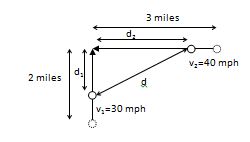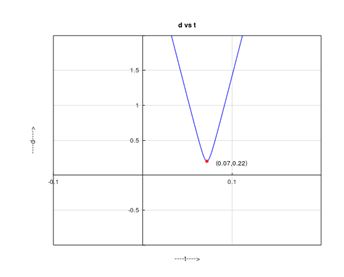
Concept explainers
19. Uniform Motion Two cars are approaching an intersection. One is 2 miles south of the intersection and is moving at a constant speed of 30 miles per hour. At the same time, the other car is 3 miles east of the intersection and is moving at a constant speed of 40 miles per hour.
Build a model that expresses the distance d between the cars as a function of time t.
[Hint: At , the cars are 2 miles south and 3 miles east of the intersection, respectively.]
(b) Use a graphing utility to graph . For what value of t is d smallest?
To find:
a. To build a model that expresses distance between two cars as a function of time .
Answer to Problem 19AYU
Solution:
a.
Explanation of Solution
Given:
Two cars are travelling perpendicular to each other with velocities 30 miles/hr and 40 miles/hr. One is 2 miles south of intersection and other is 3 miles east of intersection.
Calculation:
a. The motion of the cars can be represented as the figure below:

Let, be the velocity of the car travelling south = 30mph.
Let, be the velocity of the car travelling west = 40 mph.
Let, be the distance from the intersection at time of the car travelling south.
Let, be the distance from the intersection at time of the car travelling east.
The distance between the two cars at any time ‘’ can be written as
Substituting .
Therefore the distance between the cars at any time is .
To find:
b. Graph the function and find the value of at which is smallest.
Answer to Problem 19AYU
Solution:
b.
Explanation of Solution
Given:
Two cars are travelling perpendicular to each other with velocities 30 miles/hr and 40 miles/hr. One is 2 miles south of intersection and other is 3 miles east of intersection.
Calculation:
b. Graph the function and find the value of at which is smallest.

From the graph it can be seen that when , the distance between the cars ‘’ attains its minimum value . Therefore, is smallest when .
Chapter 2 Solutions
Precalculus
Additional Math Textbook Solutions
Elementary Statistics
Calculus for Business, Economics, Life Sciences, and Social Sciences (14th Edition)
Elementary Statistics: Picturing the World (7th Edition)
Pre-Algebra Student Edition
College Algebra (7th Edition)
College Algebra with Modeling & Visualization (5th Edition)
- = 5 37 A 4 8 0.5 06 9arrow_forwardConsider the following system of equations, Ax=b : x+2y+3z - w = 2 2x4z2w = 3 -x+6y+17z7w = 0 -9x-2y+13z7w = -14 a. Find the solution to the system. Write it as a parametric equation. You can use a computer to do the row reduction. b. What is a geometric description of the solution? Explain how you know. c. Write the solution in vector form? d. What is the solution to the homogeneous system, Ax=0?arrow_forward2. Find a matrix A with the following qualities a. A is 3 x 3. b. The matrix A is not lower triangular and is not upper triangular. c. At least one value in each row is not a 1, 2,-1, -2, or 0 d. A is invertible.arrow_forward
- Find the exact area inside r=2sin(2\theta ) and outside r=\sqrt(3)arrow_forwardA 20 foot ladder rests on level ground; its head (top) is against a vertical wall. The bottom of the ladder begins by being 12 feet from the wall but begins moving away at the rate of 0.1 feet per second. At what rate is the top of the ladder slipping down the wall? You may use a calculator.arrow_forwardExplain the focus and reasons for establishment of 12.4.1(root test) and 12.4.2(ratio test)arrow_forward
- Use 12.4.2 to determine whether the infinite series on the right side of equation 12.6.5, 12.6.6 and 12.6.7 converges for every real number x.arrow_forwarduse Cauchy Mean-Value Theorem to derive Corollary 12.6.2, and then derive 12.6.3arrow_forwardExplain the focus and reasons for establishment of 12.5.4arrow_forward
 Calculus: Early TranscendentalsCalculusISBN:9781285741550Author:James StewartPublisher:Cengage Learning
Calculus: Early TranscendentalsCalculusISBN:9781285741550Author:James StewartPublisher:Cengage Learning Thomas' Calculus (14th Edition)CalculusISBN:9780134438986Author:Joel R. Hass, Christopher E. Heil, Maurice D. WeirPublisher:PEARSON
Thomas' Calculus (14th Edition)CalculusISBN:9780134438986Author:Joel R. Hass, Christopher E. Heil, Maurice D. WeirPublisher:PEARSON Calculus: Early Transcendentals (3rd Edition)CalculusISBN:9780134763644Author:William L. Briggs, Lyle Cochran, Bernard Gillett, Eric SchulzPublisher:PEARSON
Calculus: Early Transcendentals (3rd Edition)CalculusISBN:9780134763644Author:William L. Briggs, Lyle Cochran, Bernard Gillett, Eric SchulzPublisher:PEARSON Calculus: Early TranscendentalsCalculusISBN:9781319050740Author:Jon Rogawski, Colin Adams, Robert FranzosaPublisher:W. H. Freeman
Calculus: Early TranscendentalsCalculusISBN:9781319050740Author:Jon Rogawski, Colin Adams, Robert FranzosaPublisher:W. H. Freeman
 Calculus: Early Transcendental FunctionsCalculusISBN:9781337552516Author:Ron Larson, Bruce H. EdwardsPublisher:Cengage Learning
Calculus: Early Transcendental FunctionsCalculusISBN:9781337552516Author:Ron Larson, Bruce H. EdwardsPublisher:Cengage Learning





